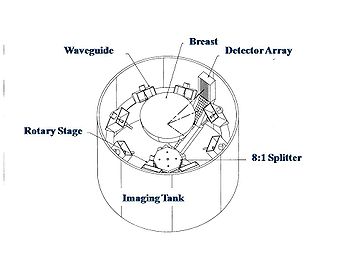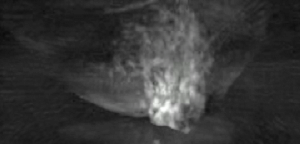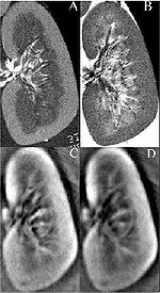
Thermoacoustic imaging
Encyclopedia
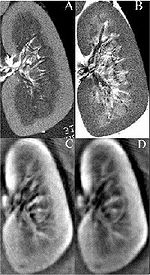
Electromagnetic radiation
Electromagnetic radiation is a form of energy that exhibits wave-like behavior as it travels through space...
. But Alexander Graham Bell
Alexander Graham Bell
Alexander Graham Bell was an eminent scientist, inventor, engineer and innovator who is credited with inventing the first practical telephone....
first reported the physical principle upon which thermoacoustic imaging is based a century earlier. He observed that audible sound could be created by illuminating an intermittent beam of sunlight onto a rubber sheet. Shortly after Bowen's work was published, other researchers proposed methodology for thermoacoustic imaging using microwaves. In 1994 researchers used an infrared laser to produce the first thermoacoustic images of near-infrared optical absorption in a tissue-mimicking phantom, albeit in two dimensions (2D). In 1995 other researchers formulated a general reconstruction algorithm by which 2D thermoacoustic images could be computed from their "projections," i.e. thermoacoustic computed tomography (TCT). By 1998 researchers at Indiana University Medical Center http://medicine.iu.edu/body.cfm?id=926 extended TCT to 3D and employed pulsed microwaves to produce the first fully three-dimensional (3D) thermoacoustic images of biologic tissue [an excised lamb kidney (Fig. 1)]. The following year they created the first fully 3D thermoaocustic images of cancer in the human breast, again using pulsed microwaves (Fig. 2). Since that time, thermoacoustic imaging has gained widespread popularity in research institutions worldwide.http://www.medphys.ucl.ac.uk/research/mle/index.htmhttp://bmo.tnw.utwente.nl/bmo/techniques.htmhttp://www.uwm.edu/~zhang25/http://www.bme.ogi.edu/biomedicaloptics/wang/http://www.engr.uconn.edu/ece/labs/optlab/http://pai.uibk.ac.at/http://www.ultrasound.med.umich.edu/Projects/Photo_Acoustic_Tomography.html As of 2008, three companies were developing commercial thermoacoustic imaging systems - Seno Medical,http://www.senomedical.com/ Endra, Inc.http://www.enlightbio.com/content/endra/ and OptoSonics, Inc.http://www.optosonics.com

Thermoacoustic wave production
Sound, which propagates as a pressure wave, can be induced in virtually any material, including biologic tissue, whenever time-varying electromagnetic energy is absorbed. The stimulating radiation that induces these thermally generated acoustic waves may lie anywhere in the electromagnetic spectrum, from high-energy ionizing particles to low-energy radio waves. The term “photoacoustic”Photoacoustic imaging in biomedicine applies to this phenomenon when the stimulating radiation is optical, while “thermoacoustic” is the more general term and refers to all radiating sources, including optical.The process by which thermoacoustic waves are generated is depicted in the Figure 3. It can be understood as a four-step process:
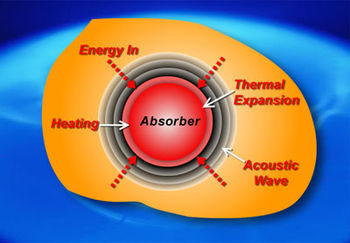
Radio waves
Radio waves are a type of electromagnetic radiation with wavelengths in the electromagnetic spectrum longer than infrared light. Radio waves have frequencies from 300 GHz to as low as 3 kHz, and corresponding wavelengths from 1 millimeter to 100 kilometers. Like all other electromagnetic waves,...
or microwaves.
2. The absorbed energy is converted to heat, which raises the temperature of the tissue, typically by less than 0.001 degree Celsius.
3. The increase in the temperature of the tissue causes the tissue to expand in volume, however slightly.
4. This mechanical expansion produces an acoustic wave
Acoustic wave
Acoustic waves are a type of longitudinal waves that propagate by means of adiabatic compression and decompression. Longitudinal waves are waves that have the same direction of vibration as their direction of travel. Important quantities for describing acoustic waves are sound pressure, particle...
that propagates outward in all directions from the sight of energy absorption at the velocity of sound in biologic tissue, approximately 1.5 mm per microsecond.
When the tissue is irradiated with a pulse, the acoustic frequencies that characterize the acoustic wave span a range from zero to 1/(pulse width). E.g., a 1 microsecond pulse produces acoustic frequencies from zero to approximately 1 megahertz (MHz). Shorter pulses produce a wider range of acoustic frequencies. Frequencies greater than 1 MHz are referred to as ultrasonic, and are also associated with medical ultrasound
Ultrasound
Ultrasound is cyclic sound pressure with a frequency greater than the upper limit of human hearing. Ultrasound is thus not separated from "normal" sound based on differences in physical properties, only the fact that humans cannot hear it. Although this limit varies from person to person, it is...
applications.
Image formation principles
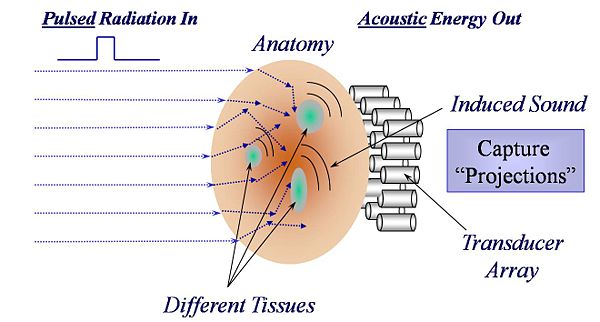
Laser
A laser is a device that emits light through a process of optical amplification based on the stimulated emission of photons. The term "laser" originated as an acronym for Light Amplification by Stimulated Emission of Radiation...
or a microwave antenna
Antenna (radio)
An antenna is an electrical device which converts electric currents into radio waves, and vice versa. It is usually used with a radio transmitter or radio receiver...
, to deliver energy to the anatomy being studied, and one or more acoustic detectors coupled acoustically to the outside surface of the anatomy, as is illustrated in Fig. 4.
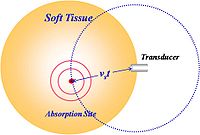
Detector geometries
Three generic detector configurations have been used: a spherically focused transducer; a linear (or curve-linear) array of transducers, focused in one dimension; or, a 2D array of unfocused transducers. In general, a single, focused transducer can image a single line through a 3D volume. A linear (1D) array, be it straight or curved, can image a 2D plane, but to image a full 3D volume requires a 2D array of transducers.Focused Transducer
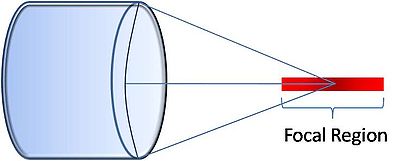
Focus (optics)
In geometrical optics, a focus, also called an image point, is the point where light rays originating from a point on the object converge. Although the focus is conceptually a point, physically the focus has a spatial extent, called the blur circle. This non-ideal focusing may be caused by...
. Time-of-flight information is used to estimate the thermoacoustic signal strength along this line. A 2D image can be assembled a line-at-a-time by translating the focused transducer laterally along a linear path. A 3D image can be built up by scanning the transducer along a rectilinear
Rectilinear
Rectilinear may refer to:* Rectilinear grid, a tessellation of the Euclidean plane* Rectilinear lens, a photographic lens* Rectilinear locomotion, a form of animal locomotion* Rectilinear polygon, a polygon whose edges meet at right angles...
path within a 2D plane.http://labs.seas.wustl.edu/bme/Wang/epub/2006HZ-KM-PATfunct.pdf The ability to distinguish thermoacoustic signals along the line of focus (axial resolution) is superior to distinguishing thermoacoustic signals transverse to the line of focus (lateral resolution). For this reason the lateral spatial resolution is three- to four-times worse than the axial spatial resolution using this approach.
Linear array

2D array
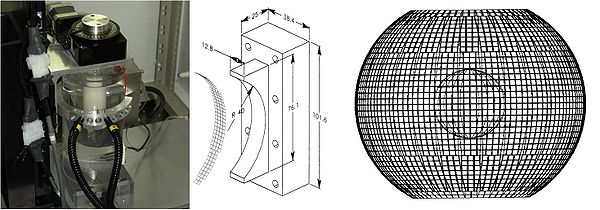
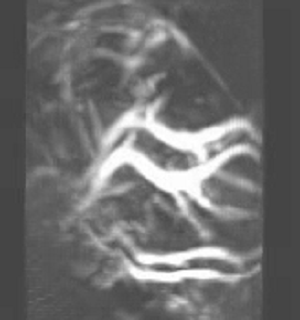
Microwaves have also been used to form 3D thermoacoustic images of the human breast. One of the first devices to do so is depicted in Fig. 10. It consisted of an array of eight waveguides, which directed microwave energy into the breast. A transducer array was rotated in synchrony with the waveguides in order to acquire sufficient data to reconstruct the internal structures of the breast. Figure 11 shows an animation of the typical glandular tissue pattern in a normal breast.
